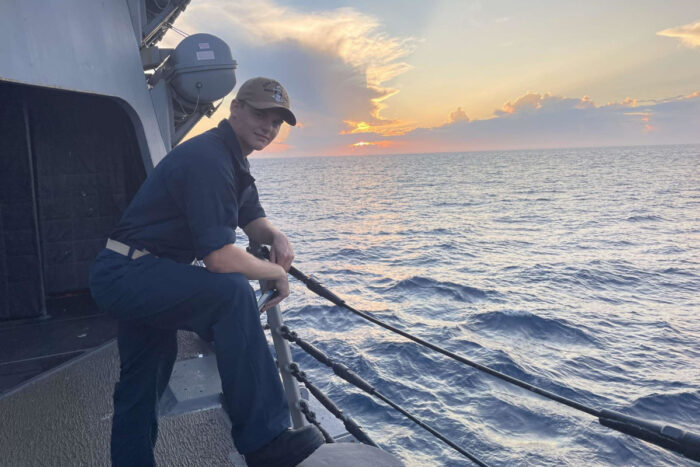For our first sustainability themed student profile of 2024, meet Churchill Scholar Anders Gulbrandson. Anders is undertaking an MPhil in Chemistry before starting his military career in the Navy.
His area of interest is “mesoporous materials,” or any material that contains pores, like those on a sponge, between 2 and 50 nanometres in diameter. His past research has explored the ability of these systems to create advanced, functional textiles from renewable materials such as cotton and he is currently working on applying similar systems to energy efficient catalysis in the Professor Andrew Wheatley Lab Group at Cambridge.
Born and raised in Orono, Minnesota, a small town in the northern United States, Anders spent his childhood playing ice hockey in winter, swimming in one of Minnesota’s 10,000 lakes in summer, and spending time outdoors whenever possible. Before moving away to college, he worked as a dockhand at a local marina and as a beekeeper.
For his undergraduate degree Anders studied Chemistry at the United States Naval Academy and participated in chemistry research in the Captain David Durkin/Professor Paul Trulove lab group. Working his way up from cleaning glassware, he was accepted into the Trident Scholar program – the Naval Academy’s research-oriented program for seniors that culminates with a thesis and public presentation. His thesis, “Mesoporous Cellulose Scaffoldings“, was a synthesis between the biopolymer, nanomaterial, and high surface area material research being conducted in the lab group at the time, as outlined in his Trident Scholar Presentation. Anders also spent summers at Vanderbilt University and MIT conducting related research and you can see a complete list of his project collaborations here.
Looking back at what first sparked his interest in science, Anders credits his physician grandfather, who remains to this day a farmer in rural Minnesota.
As a child, I have fond memories of walking through my grandfather’s farm, planting trees, looking at his bees, and viewing samples we collected throughout the day on his old medical microscope—which I am fortunate to say he gifted me for my 21st birthday.
As Anders recalls, these experiences drew him towards science as a whole, and when he entered college, he was taken under the wing of Captain David Durkin, who, along with Professor Paul Trulove and their postdoctoral researchers, ‘taught me everything I know about proper chemistry research.’ As Anders explains, ‘without Captain Durkin taking a chance on me, I would never be the chemist I am today.’
He is hugely grateful for the opportunity to study at Churchill and Cambridge through the Churchill Scholarship, and to the US Navy for realising the immense impact higher education has on personnel before completing their service requirements.
Winning the Churchill Scholarship has been a transformative experience. Never would I have imagined my studies would bring me to an institution like Cambridge, let alone on scholarship. I remember when I first found out I had received the scholarship, I was eating a fried egg. I then spent the next 15 minutes wiping said fried egg off the wall the while in a state of complete disbelief.
Anders settled quickly into life at Churchill and has particular praise for the on-site facilities; ‘Churchill has by far the best recreational spaces of any other college. The useable green spaces, gardens, and running paths are unmatched!’
Outside his studies Anders plays for the Cambridge Men’s Blues Varsity Hockey Team which you can follow on Instagram (@cuihc1885) to get team updates and schedule information. He also enjoys exercising, reading and collecting and listening to vinyl records. More recently, he has developed an interest in massage therapy and growing his own pine trees!
After completing his current studies, Anders will begin his service in the US Navy, studying to become a qualified submariner and nuclear propulsion officer. He will serve the next five years aboard a submarine, but after his service he intends to return to the chemistry lab and continue his research on high surface area materials.
- Varsity match v. Oxford
- US Naval Academy Training


